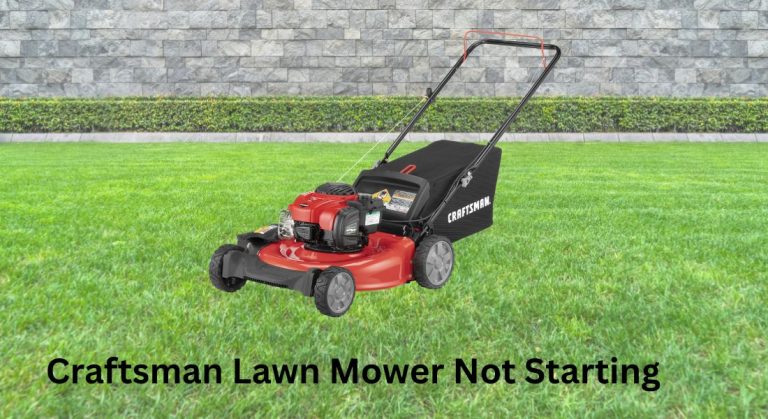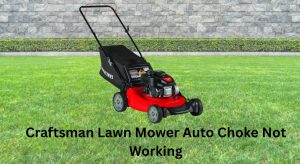Your Craftsman lawn mower not starting can turn a simple mowing day into a frustrating headache. The good news? Most no-start issues come down to a few common culprits like stale fuel, a clogged carburetor, or a dead spark plug—and you can often fix them in minutes. Quick fix: check the fuel, replace the spark plug, and clean or replace the air filter. For many owners, this simple trio gets the engine to fire right up.
In this comprehensive guide, you’ll learn every proven method to diagnose and fix a Craftsman mower that won’t start—push mowers and riding models included. We’ll cover common causes, step-by-step solutions from beginner to advanced, preventive maintenance tips, and when it’s time to call a pro. By the end, you’ll have your mower running smoothly and know how to keep it that way.
Common Causes of Craftsman Lawn Mower Not Starting

- Stale or contaminated fuel (older than 30-60 days)
- Clogged carburetor or dirty fuel jet
- Dirty or failed spark plug
- Flooded engine (smell of fuel, wet plug)
- Clogged air filter or blocked intake
- Dead battery (riding mowers), corroded terminals
- Faulty ignition switch, safety switches, or starter solenoid (riders)
- Bad fuel filter or fuel line blockage
- Low oil level or wrong oil viscosity
- Sheared flywheel key (after striking an object)
- Choke not set correctly or bad primer bulb
- Water in fuel from ethanol separation
- Old or gummed-up fuel cap vent causing vacuum lock
How to Fix a Craftsman Lawn Mower Not Starting

Below are methods ordered from quickest to most involved. Always work in a well-ventilated area.
Important: Disconnect the spark plug boot before working on the mower. For riding mowers, also remove the key and disconnect the negative battery cable.
Method 1: Quick Start Checks (5–10 minutes)
Diagnosing the Issue
- Does the engine crank? Push mowers: pull cord feels normal; riders: engine turns but won’t fire. If it doesn’t crank, skip to Method 4.
- Smell fuel? Might be flooded (see Testing below).
- Last refuel date? Fuel older than 60 days is suspect.
Fix Steps
- Check fuel level and quality
– If fuel is older than 60 days, drain the tank and carburetor bowl, and refill with fresh E10 (max 10% ethanol) or ethanol-free fuel.
– Add fuel stabilizer if storing fuel >30 days. - Inspect and replace the spark plug
– Remove the plug (common sizes: 13/16” or 5/8”).
– If fouled, oily, or cracked, replace with the recommended plug (e.g., Briggs & Stratton 491055T, Champion RJ19LM, NGK BPR6ES—verify your model).
– Set gap to 0.030 in (0.76 mm) unless your engine spec differs. - Check the air filter
– Foam filter: wash with warm soapy water, dry, and lightly oil; replace if degraded.
– Paper filter: tap out debris; replace if dark/clogged. - Verify choke/primer operation
– For primer bulb models, press 3–5 times.
– For choke levers, set to Choke for cold starts; move to Run after the engine fires.
Testing
- Pull start or turn the key. If it briefly runs then dies, fuel delivery is likely restricted; go to Method 2.
- If there is strong fuel smell and repeated no-start, open throttle, turn off choke, and let the mower sit 10–15 minutes to clear a flooded cylinder. Try starting again with no choke.
Method 2: Fuel System and Carburetor Cleaning (30–60 minutes)
Old fuel gums up jets and passages, starving the engine.
Diagnosing the Issue
- Starts with starting fluid but dies: clogged carburetor.
- Runs only on partial choke: lean condition, likely dirty main jet.
- Fuel leaks or sticky primer bulb: cracked lines or diaphragm issues (on some carb types).
Fix Steps
- Drain old fuel
– Use a siphon or remove the fuel line at the carb, catching fuel in a safe container. - Replace the fuel filter (if equipped)
– Inline filter on riders; some push mowers rely on the tank screen. Ensure arrow points toward carb. - Clean the carburetor bowl and jet (common on Briggs/Predator-style float carbs)
– Remove the 10mm bowl nut (often also the main jet). Note: The bowl nut has tiny holes—clean them with carb cleaner and a soft wire.
– Remove the bowl, clean inside, and inspect the float and needle. Ensure float moves freely.
– Spray carb cleaner through all passages. Use compressed air if available.
– Replace the bowl gasket if swollen or torn. - For diaphragm carbs (classic small Briggs side-pull engines)
– Remove the carb from the tank.
– Replace the diaphragm and gasket kit; clean screen in tank and pickup tube. - Reassemble and refill with fresh fuel
– Use high-quality fresh gasoline; consider ethanol-free if available.
Testing
- Prime or choke and start. If the engine surges or only runs on choke, repeat jet cleaning or install a full carburetor rebuild kit. If still no-start, move to ignition checks.
Method 3: Ignition and Spark System (15–30 minutes)
Diagnosing the Issue
- No spark? The engine won’t fire regardless of fuel.
- Weak intermittent spark may cause backfiring or short runs.
Fix Steps
- Check for spark
– Remove the spark plug, reconnect the boot, ground plug threads to metal, and pull the starter. Look for a strong blue spark.
– No spark? Try a new plug first. - Inspect and adjust the coil/armature air gap
– Remove shroud to access the coil next to the flywheel.
– Clean rust/debris from flywheel magnets.
– Set gap to 0.010–0.014 in (~0.25–0.36 mm) using a business card feeler gauge. - Check the stop/kill wire
– Ensure the kill wire isn’t shorted to ground by damaged insulation or a stuck safety switch. Temporarily disconnect the kill wire at the coil for testing (engine may not stop without reconnecting—block intake to kill). - Replace faulty ignition coil if no spark persists
– Match the coil to your engine model (e.g., Briggs & Stratton model/type codes). Torque mounting screws snugly.
Testing
- Reinstall the plug (gap 0.030 in) and attempt to start. If spark is good but it still won’t start, re-check fuel and compression.
Method 4: Starting/Cranking and Battery Issues (Riding Mowers) (15–45 minutes)
If your Craftsman riding mower doesn’t crank or clicks only, address the starting circuit.
Diagnosing the Issue
- Single click: likely solenoid or weak battery.
- Rapid clicking: battery low or corroded connections.
- No click: ignition switch, fuse, or safety switch fault.
Fix Steps
- Test and charge the battery
– Measure voltage: 12.6V+ fully charged; <12.2V is low.
– Charge to 12.6–12.8V. Load-test if possible (drops below ~9.6V under load indicates failure). - Clean and tighten battery terminals and grounds
– Remove corrosion with a wire brush; apply dielectric grease.
– Confirm frame ground strap is tight and clean. - Check fuses and wiring
– Replace blown fuses with same rating. Inspect for mouse damage on harnesses. - Test the solenoid
– With key in start and brake engaged, listen for click. If voltage present at trigger but no crank, replace solenoid.
– Bridge large solenoid lugs briefly with an insulated tool to test starter motor (sparks possible). If starter spins, solenoid is bad. If not, check starter or engine bind. - Safety switches
– Confirm seat switch, brake/clutch switch, and blade/PTO switch are working. Bypass only for testing, then restore properly.
Testing
- Attempt start with parking brake set, PTO off, and in neutral. If engine cranks well but won’t fire, return to Methods 1–3.
Method 5: Airflow, Compression, and Mechanical Checks (20–60 minutes)
Diagnosing the Issue
- Pull cord is very easy: low compression or stuck valve.
- Sudden no-start after hitting an object: sheared flywheel key.
- Backfire through carb: timing off or intake valve issue.
Fix Steps
- Air filter and intake
– Ensure filter is not soaked with oil/fuel. Replace if saturated. - Check oil level and viscosity
– Low oil may trigger low-oil shutdown (on some engines) or cause damage.
– Use SAE 30 for summer above 40°F (4°C), or 10W-30 for varied temps per manual. - Inspect flywheel key
– Remove flywheel nut and use a puller to lift flywheel.
– If key is sheared, replace with the correct soft key (don’t substitute steel). Torque flywheel nut to spec (often 55–65 ft-lb—verify for your engine). - Valve clearance (OHV engines)
– Remove valve cover, rotate to compression stroke with piston 1/4″ past TDC.
– Set intake/exhaust lash to typical spec: 0.004–0.006 in intake, 0.006–0.008 in exhaust (check your engine manual). - Compression test
– 80–120 psi is typical for small engines. Below ~60 psi suggests valve, head gasket, or ring issues.
Testing
- After adjustments, start the engine. If compression is still low, consider head gasket replacement or professional service.
How to Prevent Future Starting Issues
- Use fresh gasoline and add stabilizer if storing more than 30 days.
- Run the engine dry or shut off fuel valve before storage to prevent carb gumming.
- Replace spark plug annually or every 50 hours.
- Clean or replace the air filter every 25 hours (more often in dusty conditions).
- Change oil every 25–50 hours and before seasonal storage.
- Keep battery on a maintainer during off-season (riding mowers).
- Inspect and clean fuel cap vent; replace if clogged.
Pro Tips
- Use ethanol-free fuel (E0) or a high-quality stabilizer to reduce carb varnish.
- When cleaning carb jets, avoid oversized wire that can enlarge metering holes; use a bristle or jet needle.
- If the engine only runs with the gas cap loose, the cap vent is clogged—replace the cap.
- Label and photo wiring connections before disassembly, especially on riders.
- Replace fuel lines older than 3–4 years; ethanol hardens and cracks rubber.
- Keep a spare plug, air filter, and carb bowl gasket on hand for mid-season fixes.
- Store the mower with the tank 95% full and stabilizer added to reduce moisture ingress if you don’t drain it.
When to Call a Professional
- Repeated no-spark issues after coil and plug replacement.
- Compression below spec or suspected internal engine damage.
- Sheared/broken crankshaft after blade impact.
- Electrical harness faults you can’t trace, intermittent shutoffs, or module failures on newer riders.
- Carburetors with warped bodies or persistent flooding despite rebuild.
What to look for in a service provider:
– Certified small engine technician (Briggs & Stratton, Kohler, Kawasaki certifications).
– Clear diagnostics fee and labor rates; typical shop rates: $70–$120/hr.
– Turnaround time and warranty on repairs (30–90 days is common).
Typical costs:
– Carb clean/rebuild: $75–$150
– New carburetor: $40–$120 parts, plus labor
– Ignition coil: $25–$60 parts
– Battery replacement (U1 for riders): $35–$80
– Starter or solenoid: $25–$60 parts each
Warranty notes:
– If your Craftsman mower is under warranty, contact Sears/Craftsman support before disassembly that could void coverage.
FAQs
Q: Why does my Craftsman mower only start with starting fluid?
A: That indicates a fuel delivery problem—often a clogged main jet or varnished carburetor. Clean the carb bowl and jet, replace the fuel filter, and use fresh fuel. If it still dies, rebuild or replace the carb.
Q: How do I know if my mower is flooded?
A: You’ll smell strong gasoline at the muffler or the spark plug will be wet. Turn off choke, set throttle to fast, and wait 10–15 minutes. Try starting with no choke. A new dry plug can speed recovery.
Q: My riding mower just clicks when I turn the key. What’s wrong?
A: Most often a weak battery or corroded terminals. Charge the battery to 12.6V, clean connections, and check the solenoid. Verify safety switches (seat, brake, PTO) are engaged.
Q: Can bad gas really stop my mower from starting?
A: Yes. Gasoline begins oxidizing in 30 days and ethanol attracts moisture, causing phase separation and varnish. Drain old fuel, clean the carb, and refill with fresh gas and stabilizer.
Q: What spark plug does my Craftsman mower use?
A: It depends on the engine. Common options include Champion RJ19LM, NGK BPR6ES, or Briggs 491055T. Check your engine’s model and spec plate or the owner’s manual for the exact part and gap (often 0.030 in).
Q: How often should I replace the air filter?
A: Inspect every 10 hours and replace every 25 hours or when dirty. In dusty environments, replace more frequently. A clogged filter causes rich running and hard starts.
Q: After hitting a rock, my mower won’t start and backfires. What now?
A: The flywheel key likely sheared, throwing off ignition timing. Replace the key and torque the flywheel nut to spec. Inspect the blade and crankshaft for damage.
Q: Is it safe to bypass safety switches?
A: Only temporarily for diagnostics, and with extreme caution. Restore all safeties immediately. Operating without safety switches is dangerous and may be illegal.
Alternative Solutions
Sometimes repair time outweighs cost, especially on older units with multiple failures. Consider:
| Solution | Pros | Cons | Best For |
|---|---|---|---|
| Replace carburetor assembly | Fast, reliable fix; often $40–$80 | Slightly higher cost than cleaning | Heavily varnished carbs |
| Ethanol-free fuel (E0) use | Reduces gumming, easier starts | Higher price, not always available | Seasonal storage, infrequent use |
| Battery maintainer for riders | Extends battery life, reliable starts | Requires outlet access | Off-season storage |
| Professional tune-up | Comprehensive performance restore | Labor cost | Annual maintenance |
Get Your Craftsman Lawn Mower Working Again
By following this guide, you now have multiple ways to fix your Craftsman lawn mower not starting:
– Quick-start checks: fresh fuel, new spark plug, clean air filter
– Fuel system fixes: drain stale gas, clean/rebuild carb, replace fuel filter
– Ignition solutions: verify spark, set coil gap, replace faulty coils
– Riding mower starting system: battery, solenoid, and safety switch diagnostics
– Mechanical checks: flywheel key, valve lash, compression
Don’t let a no-start ruin your day. Work through these methods in order, and you’ll likely have your mower back to life in under an hour. If you hit a dead end, a small-engine pro can finish the job quickly and safely.
Have you fixed your Craftsman mower with these steps? Share your results or specific model details in the comments to help other readers. Found this guide helpful? Bookmark it for the season and never struggle with a Craftsman lawn mower not starting again.




